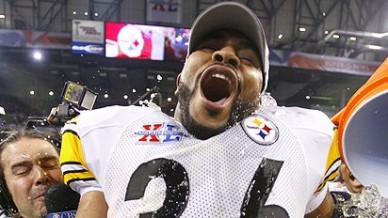 TIOPS DAILY FIVE
TIOPS DAILY FIVE
*Rumblings, Musings, Opinions*
1. Opinions of what a Hall of Famer should be are wide ranging. I’ve long been in the group that a player who dominated his sport or position at a level that few others did for even only a 4-5 year period is superior to longevity.
Hence, when it comes to the NHL for example, Eric Lindros is a Hall of Famer to me over a Mark Recchi who was a good player that played 20+ seasons and has the stats to get in the Hall of Fame, but was never a great player in the sense that he was one of the best players in the game for a short period.
Bettis kind of falls into that same category as he was not a great running back in the sense that the likes of Emmitt Smith and Barry Sanders were during his era, but the exception here is Bettis was a unique running back for his build where running back is a position that longevity has to be valued more than other positions and played a huge role in Bettis becoming a Hall of Famer.
Player-A (1st 10 NFL seasons) | 2,873 rushing attempts – 11,542 yards – 62 touchdowns |
Player-B (1st 10 NFL Seasons) | 2,618 rushing attempts – 11,241 yards – 82 touchdowns |
Player A is Jerome Bettis, Corey Dillon is Player B.
Dillon ranked in the top-10 in rushing in six of his 10 NFL seasons, including two top-5 seasons, 2nd in 2001, and 3rd in 2004 with a career-high 1,635 yards.
Bettis had five top-10 rushing seasons in his 13 year NFL career, including three top-5 seasons.
Bettis Prime Years (Age 21 – 30)
1993: 1,429 yards (2nd in NFL)
1994: 1,025 yards (9th in NFL)
1995: 637 yards (29th in NFL)
1996: 1,431 yards (3rd in NFL)
1997: 1,667 yards (3rd in NFL)
1998: 1,185 yards (12th in NFL)
1999: 1,091 yards (12th in NFL)
2000: 1,341 yards (9th in NFL)
2001: 1,072 yards (14th in NFL, played 11 games, led NFL in yards/G at 97.2)
2002: 666 yards (34th in NFL)
Both players won a Super Bowl and the difference being between the two is Dillon played 10 years, Bettis 13 years. Some may argue Dillon was the better back when comparing each others prime but there is not a peep surrounding Dillon as a Hall of Fame candidate because he’s 18th in NFL history in rushing. Those two-three extra seasons as a backup and goal line back for Bettis played a huge factor in his candidacy to have the stats to get in.
2. During Bettis’ prime years he was arguably a top-10 running back in the NFL but rarely recognized as a top-5 back. That’s why some voters had some pause with putting Bettis in the Hall despite being No. 6 all-time in rushing.
However, Bettis played during an era that was filled with premier running backs. The type of elite backs at one time that was around in the 90’s/early 2000’s may never been seen in the NFL for a while.
However, Bettis played during an era that was filled with premier running backs. The type of elite backs at one time that was around in the 90’s/early 2000’s may never been seen in the NFL for a while.
Barry Sanders, Emmitt Smith, Marshall Faulk, Eddie George, Curtis Martin and Terrell Davis for a three years period (96-98), headlined a group of premier backs during the Bettis prime years. Five of the six are Hall of Famers.
3. The NL Central Cardinals (71-40), Pirates (65-44) and Cubs (62-48) own the three best records in the National League. The Pirates should be glad the Houston Astros (61-52) left the NL Central when they did. With a big time TV deal and a owner willing to spend, the Astros would have been a handful to keep up with in the years ahead like the Cubs are going to be who many believe will be a favorite to sign David Price this winter.
4. Was speaking with an NHL assistant coach last week. One of the topics was Rob Scuderi and this coach disliking of how advance stats has so much persuasion surrounding whether someone is viewed as a quality player or not, as it’s gone from the media, pundits to now top decision makers.
The NHL assistant came in defense of Scuderi saying he’s nearly the same player he was five, six years ago and the coach was saying that as a compliment. The coached noted Scuderi is the type of player and leader he’d take on his team any day of the week and blamed the infatuation with fancy stats has ruined Scuderi’s reputation as a player
“There’s little difference between the Rob Scuderi now and the Rob Scuderi from 2009,” the coach said. “You know what wasn’t around in 2009? The Corsi phenomenon….. “Say what you want about him but a great Kings organization kept him around and Pittsburgh couldn’t wait to get him back. You still need guys like him,” the coach said.
On the advance stats narrative:
“Someone puts a chart up crushing a player [advance stats] and it spreads like wild fire. There’s a place for it in our game….. [but] way too much focus on it.”
5. The quality of play was so horrific in the Steelers preseason opener it’s near impossible to draw any conclusions. Cam Thomas who has bounced back with a solid camp was very good in the preseason opener but he should be against that type of talent, or you’d at least hope he would be.
Brandon Boykin was also very good and what to draw from that game on him is the talent he has more than anything
The one concern was Bud Dupree in how badly he struggled in getting off blocks against some linemen/tight ends who might be D-1 AA talents at best. The book on Dupree has been that he’s raw but he looked lost most of the night.
Arthur Moats might seem like a competent player but he’s one of those guys who gets exposed over the long haul. How raw Dupree has looked early for a four year college player is raising some red flags but luckily for the Steelers it’s early.
— The Daily Five returns Full-Time starting August 24th —

